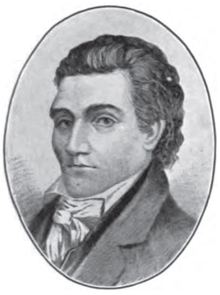| Martin Baum | |
|---|---|
 | |
| Born | (1765-06-15)June 15, 1765 Hagerstown, Maryland, U.S. |
| Died | December 14, 1831(1831-12-14) (aged 66) Cincinnati, Ohio, U.S. |
| Resting place | Spring Grove Cemetery |
Martin Baum (15 June 1765 – 14 December 1831) was an American businessman and politician.
The son of German immigrants Jacob Baum and Magdalena Elizabeth Kershner, Baum fought with General Anthony Wayne at the Battle of Fallen Timbers.
After settling in Cincinnati, Baum became active in civic affairs, and was elected mayor in 1807 and 1812. Through his agents in Baltimore, New Orleans and Philadelphia, Baum attracted a great number of German immigrants to work in his various enterprises — steamboats, a sugar refinery, a foundry, and real estate. Baum founded the Western Museum, was active in the first public library in 1802, and was one of the main pillars of the First Presbyterian Church. He married Anna Somerville Wallace in 1804.
He bought the 9-acre (36,000 m) property on Pike Street in 1812, to build his home. Benjamin Henry Latrobe, architect of the United States Capitol designed Baum's home, named the "Belmont". Baum completed construction in about 1820; the building, once lived in by Nicholas Longworth (the first) and David Sinton, is now the Taft Museum. The building is the best example of the Federal style in Cincinnati. Baum was caught in the financial upheaval of 1819–20, and he was eventually forced to deed his home back to the Bank of the United States in 1825.
Baum's leadership was instrumental, along with William Oliver, and Micajah T. Williams in developing the Maumee Valley and Port Lawrence, modern day, Toledo, Ohio.
Baum died during an influenza epidemic. He was buried in the First Presbyterian Ground. On 6 June 1853 his body was moved to Spring Grove Cemetery.
One of the cars of the Mount Adams Incline was named in his honor.
References and notes
- "Martin Baum" findagrave.com 7 November 2010
- Greve, Charles Theodore (1904). Centennial history of Cincinnati and representative citizens. Vol. 1. Chicago: Biographical Publishing Company. p. 438.
- Goss, Charles Frederic (1912). Cincinnati, the Queen City, 1788-1912. Vol. 1. Cincinnati: S J Clarke Publishing Company. p. 96.
- "Archived copy". Archived from the original on 2008-05-16. Retrieved 2008-05-02.
{{cite web}}: CS1 maint: archived copy as title (link) "At the beginning of the 19th century, German immigrants were about 5% of Cincinnati's population. By the time of the American Civil War, Germans were one-third of the population, and by the end of the century, about 60% of Cincinnati's citizens were of German heritage. So not only did German immigrants influence society in Cincinnati, the changed it completely." - Library of Congress, Chronicling America (1908-08-01). "Martinsburg Herald. [vol. XXV, No. 4] (Martinsburg, W. Va.) 1881-1920, August 01, 1908, Image 1". Martinsburg Herald. p. 1. Retrieved 2022-07-07.
- Hosmer, Hezekiah Lord (1814-1893 (1858). "Early History of the Maumee Valley". ohiomemory.org/digital/collection.
{{cite web}}: CS1 maint: numeric names: authors list (link) - Goss, Charles Frederic (1912). Cincinnati, the Queen City, 1788-1912. Vol. 2. Cincinnati: S J Clarke Publishing Company. p. 12. Retrieved 2013-05-20.
| Political offices | ||
|---|---|---|
| Preceded byJohn S. Gano | Mayor of Cincinnati 1807 |
Succeeded byDaniel Symmes |
| Preceded byJames Findlay | Mayor of Cincinnati 1812 |
Succeeded byWilliam Stanley |
This article about a mayor in Ohio is a stub. You can help Misplaced Pages by expanding it. |